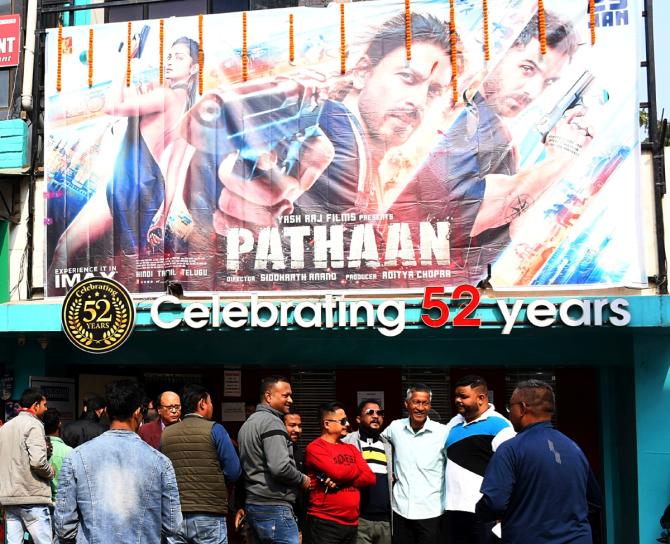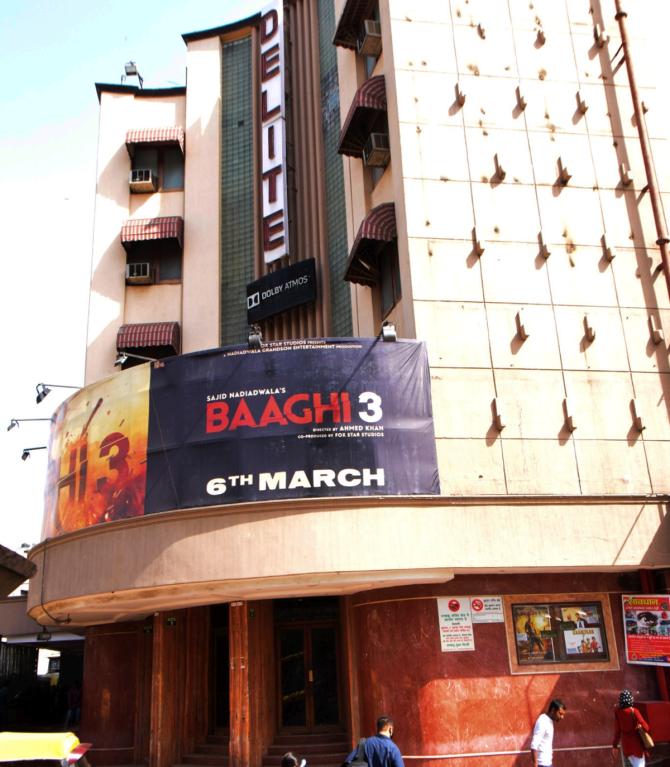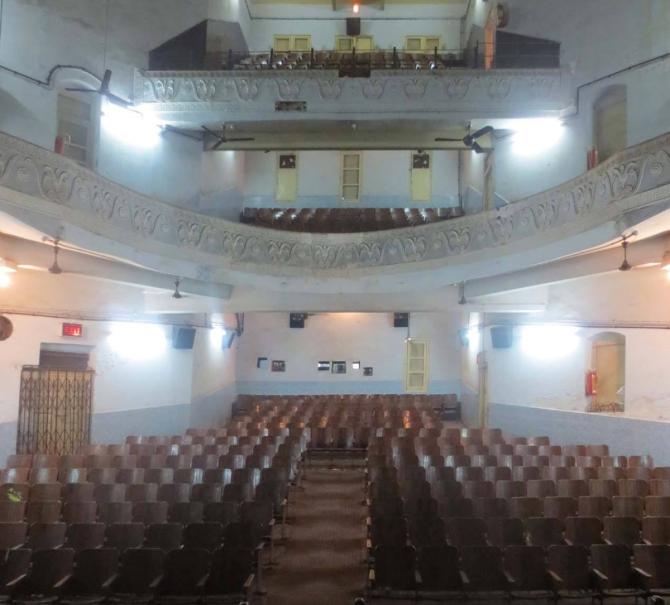 | « Back to article | Print this article |
Their number is dwindling, but single screens believe they have a place in the entertainment space.

At Delite Cinema on the edge of Old Delhi, there is still an enthusiastic, albeit lean, crowd for a morning show of Pathaan in its fourth week.
At the interval, some pass quick half-time verdicts, others pick up something from the food counter to snack on, and a few take selfies with posters in the lobby, before disappearing back into the dark hall to resume their whoops and cheers.
A few kilometres away, at Liberty Cinema in Karol Bagh, another populous place in the city, Pathaan is drawing in crowds similarly, with several couples here for a matinee on Valentine's Day.
Thanks to a record-setting blockbuster, it would seem the show can still go on at single-screen theatres that are otherwise dwindling steadily in an age of multiplexes and over-the-top platforms.
What, then, keeps them going?
Rajan Gupta, owner, Liberty Cinema, says that after the Covid shock to cinemas, there was a sense of a return to normal. But the lack of good films meant a drastic drop in business and a period of self-questioning.
"After Pathaan, it's obvious that people were not coming to cinemas because the films were not up to the mark," he says.
For nine days after the Shah Rukh Khan starrer's release on January 25, Liberty ran houseful shows.
"We are sitting on the margins and time will tell if we bounce back to profitability. But what Pathaan has done is shown that mass films are what's really required," Gupta says.
"Even in multiplexes, the business of Pathaan is far more than that of all the classy films put together."

Raj Kumar Mehrotra, owner of Delite, says that 2019 was the best year he has had, as "13-14 films crossed Rs 100 crore box-office collections, and each gave us great business."
Year 2022 also began promisingly with movies like The Kashmir Files and Sooryavanshi pulling big crowds.
A string of flops in the last six months soured things. "But with Pathaan, there has been a bounce back, and within three weeks we had collections of Rs 1.10 crore, which is extraordinary," he says.
Single screen businesses still hold firm to the belief that they continue to have their place in a changing ecosystem of entertainment.
Gupta says a multiplex simply doesn't see the kind of crowd reaction that a single screen theatre does.
"It's got to do with the class of people. Single screen audiences clap and whistle freely, with no inhibitions of what the person sitting next would think," explains Gupta.
Pricing is a USP for single screens. At Delite, for instance, the ticket price goes up to Rs 210, with a majority selling at around Rs 185 and ones for the morning show as low as Rs 85.
Gupta, who also owns another single screen theatre at Ambala in Haryana that has been lying shut since the pandemic, says there is a gap between what the masses afford and want and what the multiplex can provide. Only single screens can fill this gap, he adds.
At the same time, single screens try to woo audiences with a viewing experience that is comparable to that of multiplexes.
Delite, in fact, functions like a multiplex after it added a smaller second screen to the property in 2006.
"When multiplexes entered the scene, non-mass films that catered to a particular class disappeared from single screens," explains Mehrotra.
"So, we felt why not create a hall with the capacity of 150-odd for smaller audiences as well?"
Despite the success of Pathaan, cinema owners point out that one hit movie cannot revive or change the fortunes of single screens.
Nitin Datar, president, Cinema Owners and Exhibitors Association of India, says that before COVID-19, there were around 6,500 single screens, including touring cinemas, in the country.
Post-Covid, some 20-25 per cent of these have not reopened, he adds.
According to distributors in Delhi, four single-screen cinemas are currently running in the national capital, while around 10-11 have shut down in the past decade.
Around 1,800 movies are produced in India annually in various languages.
Of these, 250-odd are in Hindi, says Datar.
"The vast majority flops. For single screens, one hit film doesn't matter. We need around 40 superhit films in a year to do good business and survive."
After the pandemic, the single-screen audience has also turned to OTT platforms that can be accessed through smaller screens including on smartphones, Datar says.
In the pre-multiplex era, when single-screen theatres had a booming business, average seat occupancy used to be as high as 80 per cent; now it may have come down to 8-10 per cent, he adds.
"We hardly make any money. And a majority of the chunk of the profits are taken away by the big films that are released," he says.
"They hardly pay anything to the single screens, unlike multiplexes, which get 50 per cent of the collections. Single screens get 10-15 per cent of the net collections; the rest is taken by distributors. Around 200 single screens shut shop annually."

Single screen owners also point to a lack of government support as the primary reason for their decline, and view the traditional cinemas' conversion to a multiplex as a compelling choice -- if at all it is practicable. Multiplex screens, meanwhile, are numbering around 3,500 in India.
Citing government indifference, Datar says: "In Delhi and Maharashtra, for instance, the government doesn't allow cinema owners to do any other business. You have to maintain a small cinema, which is also hurting. I don't think single screens will survive beyond 10-15 years; a majority may have to convert to multiplexes."
He laments that various states had policies to help the rise of multiplexes, which included tax waivers.
"Instead of encouraging multiplexes to come up in cities, government policies should encourage more people to watch cinema at a cheaper rate," he says.
Datar is the owner of a cinema in Satara district, Maharashtra, that has been lying shut.
He is also building a multiplex at Ghatkopar in Mumbai's suburbs, and renovating another theatre in the city into a multiplex.
Conversion itself is a challenging task, he says.
"Most single screens were situated in densely populated areas. Without parking facilities, no business is possible. Projector, screen and furnishings costs will add up to around Rs 2 crore, which is not a viable investment if occupancy increases to only 20-25 per cent," says Datar.
He suggests there should be two to three screens with government subsidies. "Big, 1,000-seater screens could be turned to two screens, but for those with a capacity of 600, it's very difficult to turn them into multiplexes."

Why South does better
The fate of single screens is still comparatively better in South India, aided in no small measure by strong regional content that continues to draw audiences and, in recent years, find takers beyond as well.
N Venkatesh, the proprietor of Chennai's Woodlands Cinemas and honorary secretary, Tamil Nadu Theatre and Multiplex Owners Association, points out that single screen closure is more in rest of India, particularly North, than in the southern states.
"In Tamil Nadu, after Covid about 15 screens have shut out of the 1,500-odd that have closed down in the country as a whole. Kerala has seen a closure of 30-40 single screens, whereas in Karnataka 150 have shut," he says.
"In North India and Maharashtra, around 1,000 screens have shut post-Covid. Southern theatres screen movies in multiple languages, whereas North India is reliant only on Hindi," he explains.
He also reasons that the ticket prices in North India or Maharashtra are killing viewership compared to South.
"In Tamil Nadu, the ticket prices in multiplexes are around Rs 200 including GST and local bodies' taxes, whereas in North India it can cross Rs 1,000."
In Tamil Nadu, from the last Diwali to this year's, some 350 screens are newly opening or getting renovated, he says, adding that out of 1,145 overall, the state currently boasts 300 single screens.
Venkatesh argues that while multiplex chains, which are shareholding companies, can easily raise funds, single screens are not given bank loans even though they are classified as micro, small and medium enterprises.
The maintenance costs have also grown after the switch from analogue film reels to digital a decade-and-a-half ago, Venkatesh points out.
"Every three years, the projection and sound systems get changed. The cost of changing the projector within 15 years has gone up to Rs 1.5 crore," he says.
"To fund this update, multiplexes get bank finance whereas single screens don't. So, they cannot compete and are closing down."
Feature Presentation: Rajesh Alva/Rediff.com